Uninstall Decrypthelp@qq.com virus (Easy-to-follow Removal Guide) - Recovery Instructions Included
Decrypthelp@qq.com virus Removal Guide
Description of Decrypthelp@qq.com ransomware
Decrypthelp@qq.com is a crypto-malware that encrypts data with .java file extension
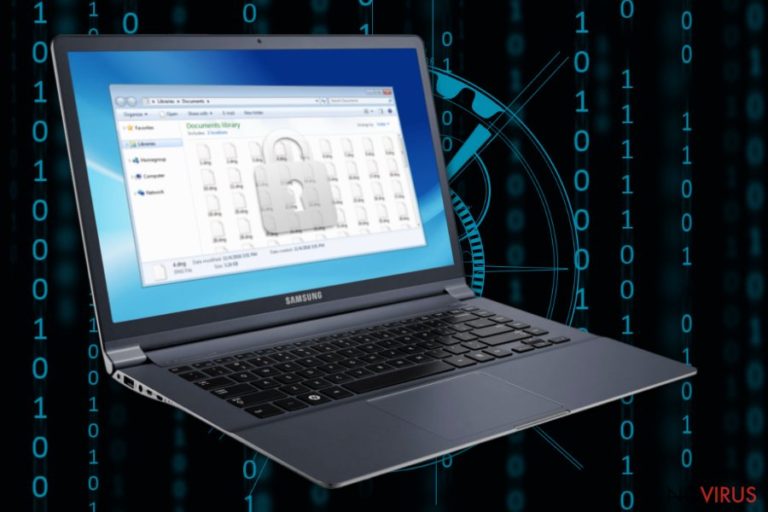
Decrypthelp@qq.com is the name of a ransomware virus that belongs to the infamous Dharma/Crysis family. Geologically it's a variation of .java ransomware, which has already been circulating on the Internet and attacking PC users for a couple of years.
AES cryptography enables the malware to lock personal files and render them useless. Every corrupted file is consequently attacked with a .[decrypthelp@qq.com].java file extension. Extortionists leave no way to manually decrypt infected files. As they explain on a ransom note, to decrypt files encrypted by Decrypthelp@qq.com, the victim has to pay a ransom.
If the victim dismisses the claim, he or she risks losing personal data, which is stored on the infected system in the most popular file types.
Upon successful data encryption, the Decrypthelp@qq.com ransomware unravels a text file instructing the victim on how the payment for a decryptor has to be made:
Your computer has been infected with Decrypthelp@qq.com Ransomware. All the files found on your drives have been encrypted with a complex algorithm. To regain your access, strictly follow the instructions, provided in the ransom notification.
Decrypthelp@qq.com.java ransom note contains a link to Bitcoin wallet, meaning that the ransomware accepts the ransom in Bitcoins only. Regardless of the digital currency accepted, cybersecurity law enforcement foster computer users not to pay the ransom. They ground such recommendation on several factors. First of all, the developers of the Decrypthelp@qq.com.java cannot be trusted because there is no evidence that they contain a decryption key at all. Second of all, crooks can provide victims with a decryptor that is capable of unlocking few file types only. The goal of ransom extortionists is to maximize their profit at any cost.
Based on the above perspectives, Decrypthelp@qq.com removal is the priority choice. Do not establish a connection with cybercriminals. Each transaction received by ransomware developers motivates them to initiate further illicit activities.
To remove Decrypthelp@qq.com ransomware from the system, our top pick security tool is FortectIntego. This anti-malware solution encompasses multiple features, including but not limited to PC's cleanup, file restore, removal/replacement of corrupted Windows Registry entries, fix of compromised system's processes.
Due to the multiplicity of unauthorized system's changes initiated by crypto-malware, manual Decrypthelp@qq.com removal is hardly possible. By initiating the analysis and modifying random system's files on your own, you can violate system's integrity and end up with a fatal crash. To prevent such kind of scenario, dedicate virus removal procedure to a professional, i.e., a robust antivirus utility.
Decrypthelp@qq.com virus removal will not recover the data automatically. To restore the files to the state before the attack, you have to pay for the decryptor, but that's not recommended. Another, recommended, the solution is to use backups if you have them or try to decrypt locked files with the help of third-party recovery software. A comprehensive virus removal guide and data recovery tips are submitted at the bottom of this article.
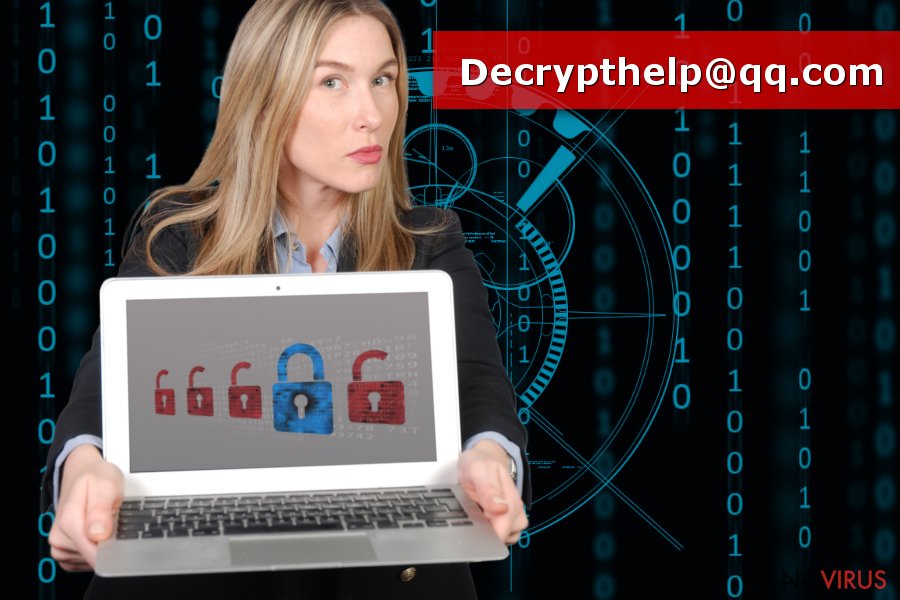
Ransomware proliferation accelerated by active freeware downloads
Ransomware payloads are actively circulating on the Internet as attachments of malicious spam emails. Malspam is a well-known malware distribution strategy misused by cyber crooks for more than a decade.
Infected email messages can be differentiated from the others by the content. Usually, they report some problems with the credit or debit cards. Product delivery problems are yet another heated topic used in social engineering attacks. To look more realistic, such messages might mimic the record keeping and stylistics of official documents or contain fake scanned files. Experts warn that spam email attachments can end up with the infection of severe cyber infection. Although the list is not definite, these are the most frequent types of malware hidden under spam email attachments:
- fake updates;
- downloads of rogue PC optimizers and anti-spyware;
- adverts injected with javaScripts;
- exploit kits.
Some basic behaviour tips on the Internet should be sufficient for you to protect the system from malware. Pick out the websites to visit carefully. Avoid landing on unknown web domains and random bypass links on them. Besides, to minimize system's vulnerability to cyber attacks, establish powerful virus protection. For this purpose, download a reputable antivirus and update it on a regular basis. Real-time protection is a must-be feature of a security tool.
TIP: protect your data in the most primitive way – create backups. Having your files on an external drive will save your day in case of ransomware infection.
Effective ways to get rid of Decrypthelp@qq.com ransomware virus
There's no other way to remove Decrypthelp@qq.com from the system as to check your PC with reliable anti-virus tool, like FortectIntego or Malwarebytes. You can try to check your computer manually. However, because experienced IT experts struggle to determine what files belong to the ransomware package, you, as a home user, will only waste your time and nerves.
Upon Decrypthelp@qq.com removal, there are several data recovery methods that you can try. Some of them require downloading third-party data recovery tools, while the others rely on inbuilt Windows features. Our recommendation – try each method one-by-one from the start.
Getting rid of Decrypthelp@qq.com virus. Follow these steps
In-depth guide for the Decrypthelp@qq.com elimination
If you cannot perform an automatic Decrypthelp@qq.com removal because it blocks the antivirus, restart your PC this way:
Important! →
The elimination guide can appear too difficult if you are not tech-savvy. It requires some knowledge of computer processes since it includes system changes that need to be performed correctly. You need to take steps carefully and follow the guide avoiding any issues created due to improper setting changes. Automatic methods might suit you better if you find the guide too difficult.
Step 1. Launch Safe Mode with Networking
Safe Mode environment offers better results of manual virus removal
Windows 7 / Vista / XP
- Go to Start.
- Choose Shutdown, then Restart, and OK.
- When your computer boots, start pressing the F8 button (if that does not work, try F2, F12, Del, etc. – it all depends on your motherboard model) a few times until you see the Advanced Boot Options window.
- Select Safe Mode with Networking from the list.
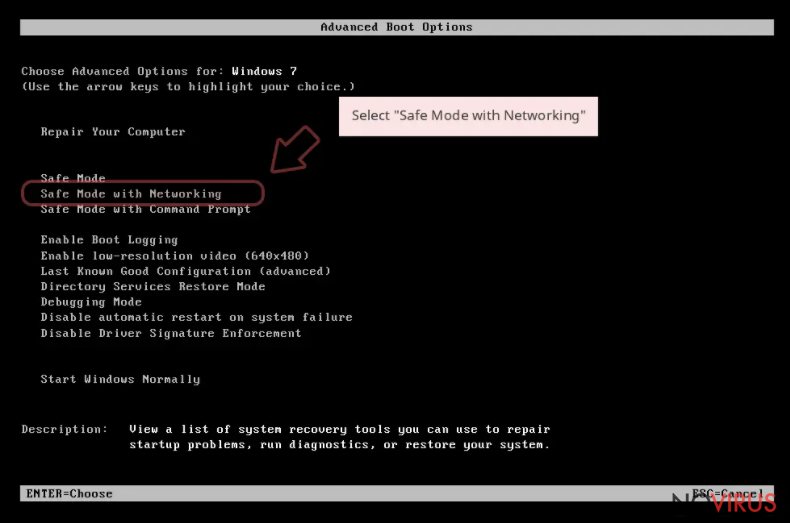
Windows 10 / Windows 8
- Right-click the Start button and choose Settings.
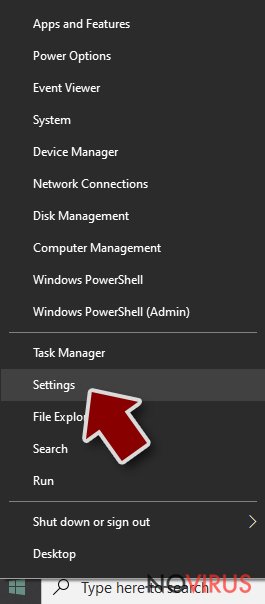
- Scroll down to find Update & Security.
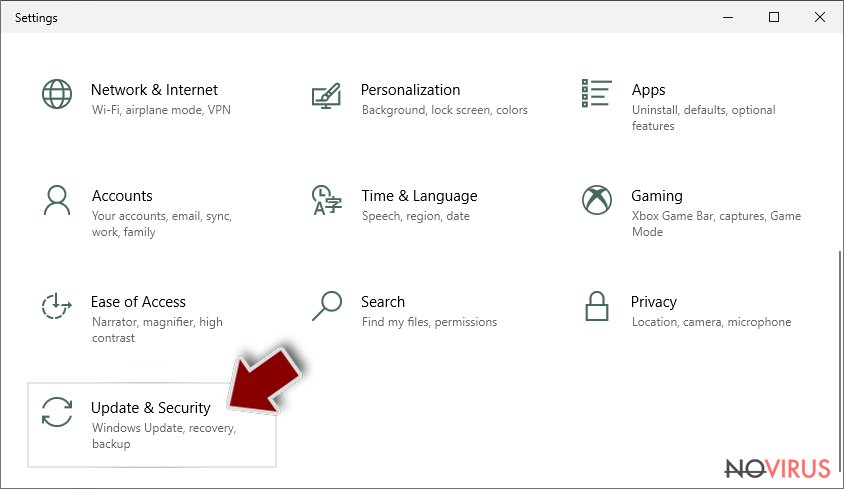
- On the left, pick Recovery.
- Scroll to find Advanced Startup section.
- Click Restart now.
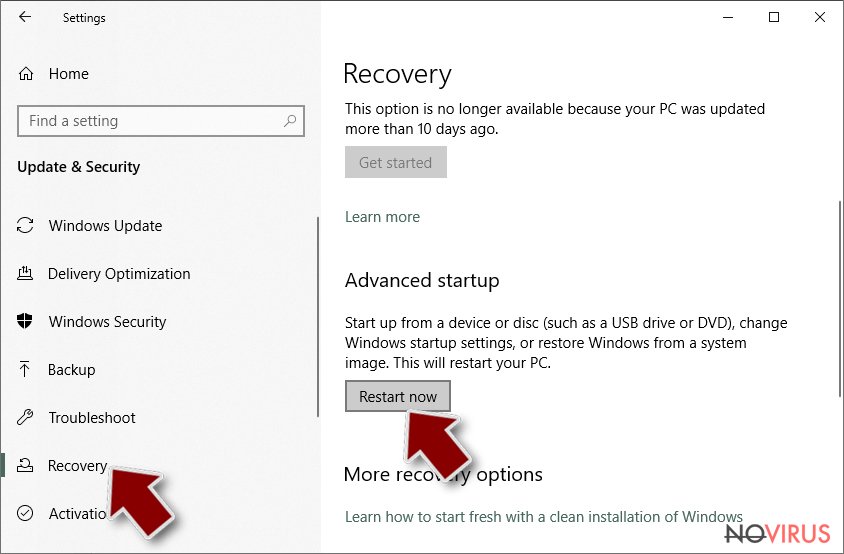
- Choose Troubleshoot.
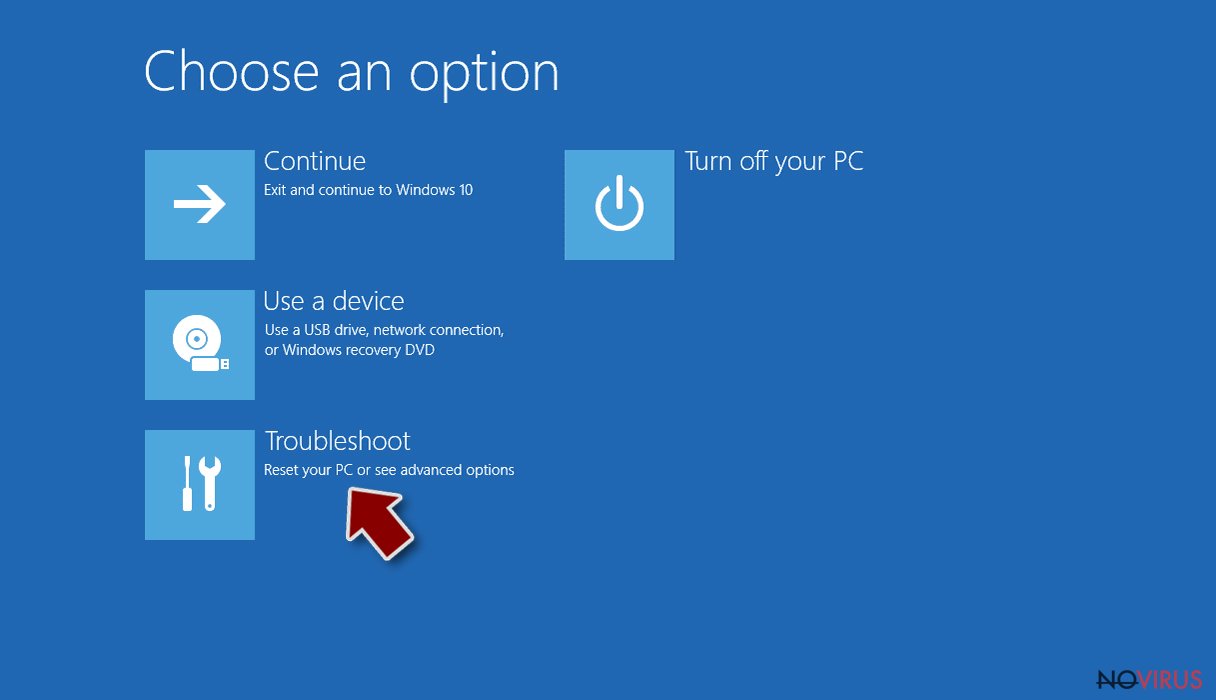
- Go to Advanced options.
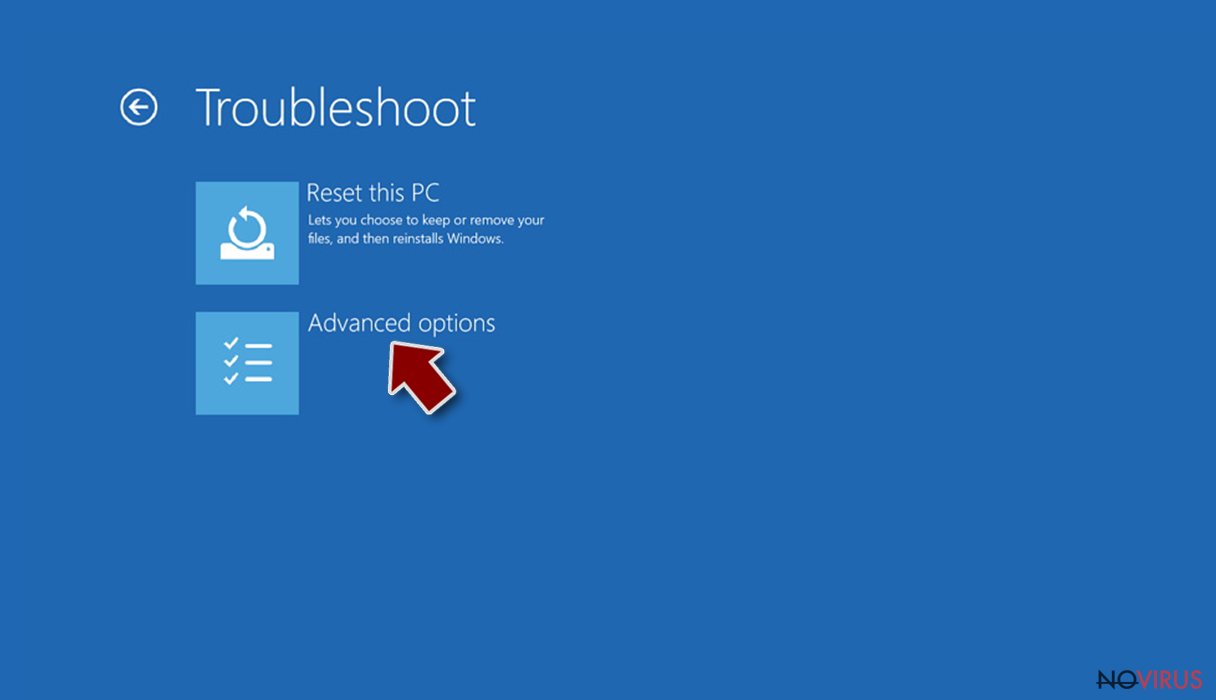
- Select Startup Settings.
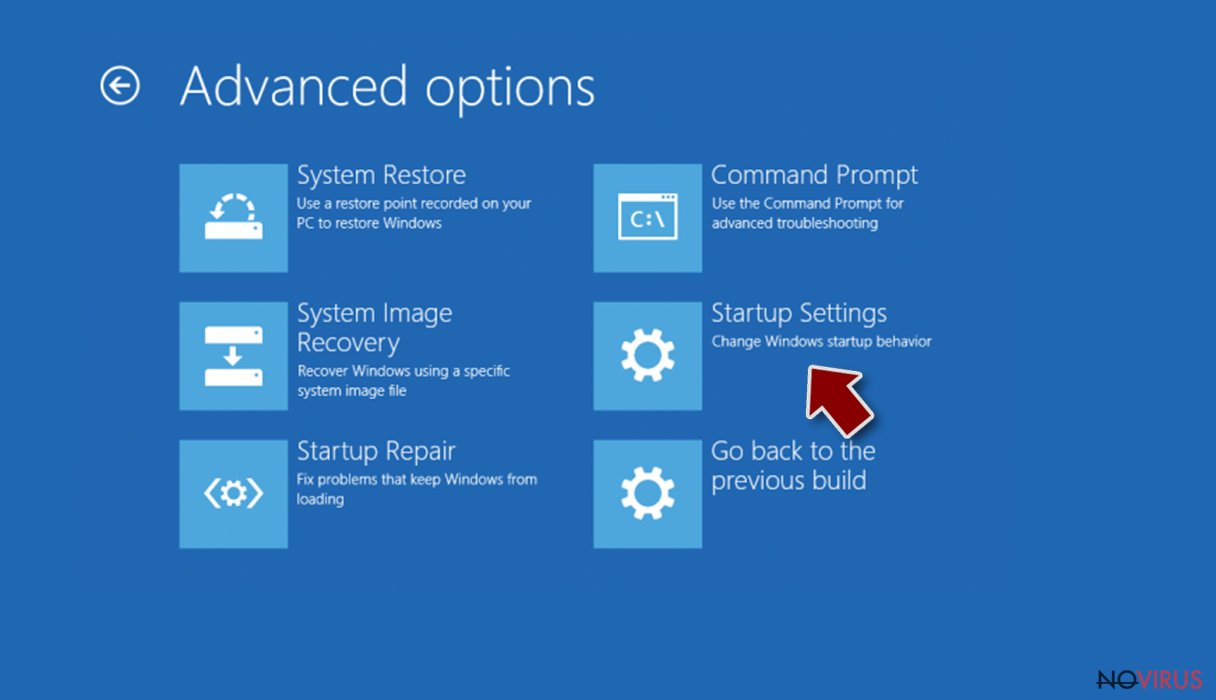
- Press Restart.
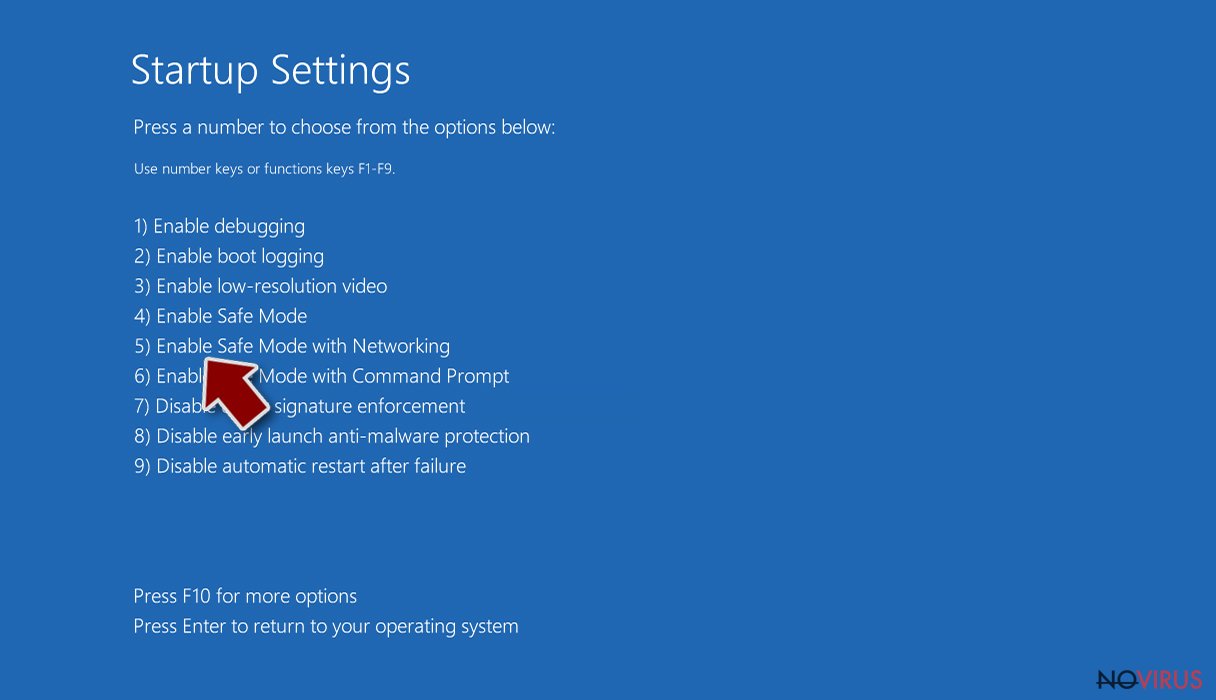
- Choose 5) Enable Safe Mode with Networking.
Step 2. End questionable processes
You can rely on Windows Task Manager that finds all the random processes in the background. When the intruder is triggering any processes, you can shut them down:
- Press Ctrl + Shift + Esc keys to open Windows Task Manager.
- Click on More details.
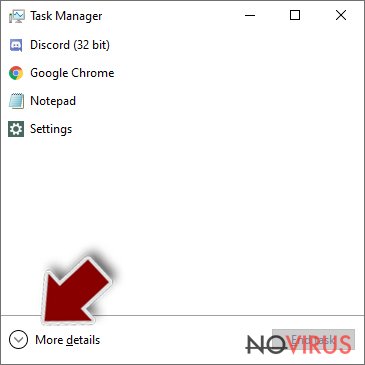
- Scroll down to Background processes.
- Look for anything suspicious.
- Right-click and select Open file location.

- Go back to the Process tab, right-click and pick End Task.
- Delete the contents of the malicious folder.
Step 3. Check the program in Startup
- Press Ctrl + Shift + Esc on your keyboard again.
- Go to the Startup tab.
- Right-click on the suspicious app and pick Disable.
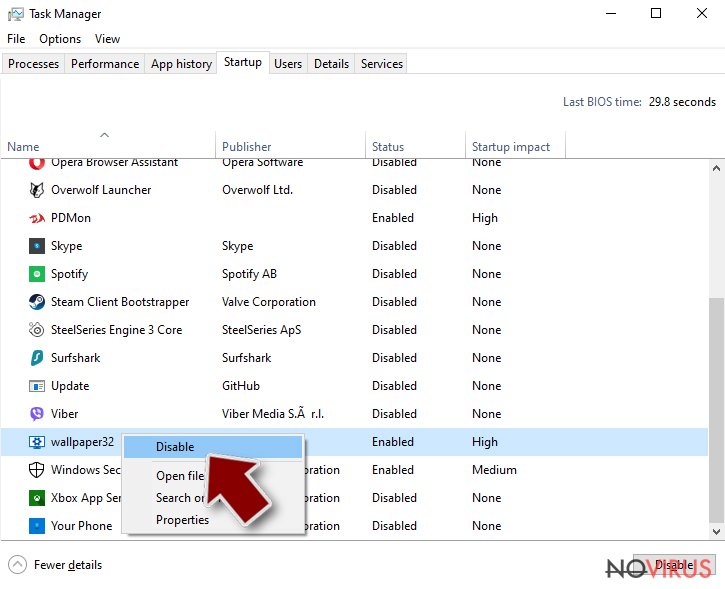
Step 4. Find and eliminate virus files
Data related to the infection can be hidden in various places. Follow the steps and you can find them:
- Type in Disk Cleanup in Windows search and press Enter.
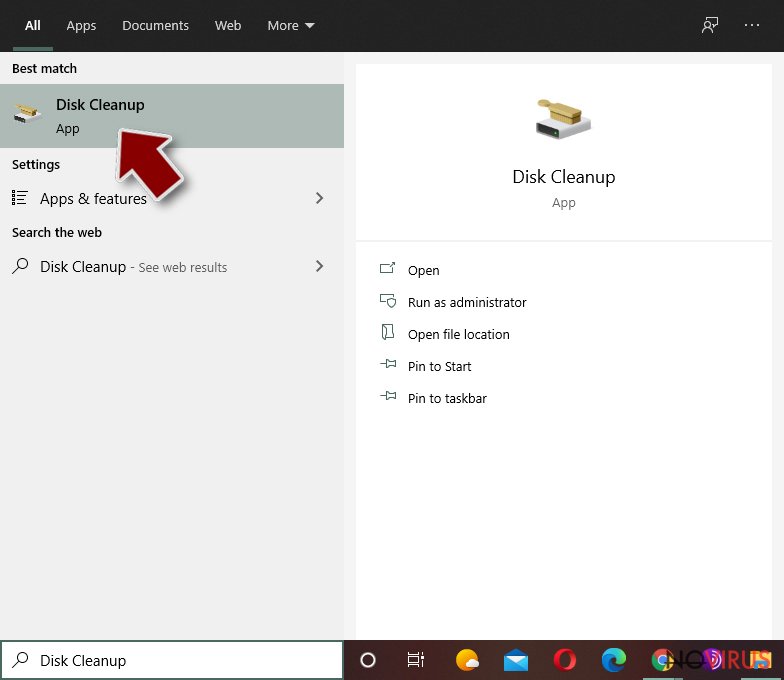
- Select the drive (C: is your main drive by default and is likely to be the one that has malicious files in) you want to clean.
- Scroll through the Files to delete and select the following:
Temporary Internet Files
Downloads
Recycle Bin
Temporary files - Pick Clean up system files.
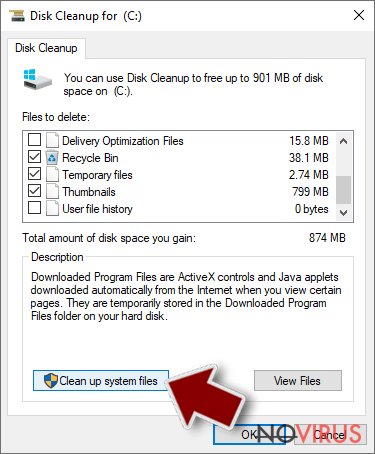
- You can also look for other malicious files hidden in the following folders (type these entries in Windows Search and press Enter):
%AppData%
%LocalAppData%
%ProgramData%
%WinDir%
After you are finished, reboot the PC in normal mode.
Eliminate Decrypthelp@qq.com using System Restore
In case the previous method ended up with a failure, try an alternative boot option:
-
Step 1: Restart your computer in Safe Mode with Command Prompt
Windows 7 / Vista / XP- Go to Start → Shutdown → Restart → OK.
- As soon as your computer starts, start pressing F8 key repeatedly before the Windows logo shows up.
-
Choose Command Prompt from the list

Windows 10 / Windows 8- Click on the Power button at the Windows login screen, and then press and hold Shift key on your keyboard. Then click Restart.
- Then select Troubleshoot → Advanced options → Startup Settings and click Restart.
-
Once your computer starts, select Enable Safe Mode with Command Prompt from the list of options in Startup Settings.

-
Step 2: Perform a system restore to recover files and settings
-
When the Command Prompt window appears, type in cd restore and press Enter.

-
Then type rstrui.exe and hit Enter..

-
In a new window that shows up, click the Next button and choose a restore point that was created before the infiltration of Decrypthelp@qq.com and then click on the Next button again.


-
To start system restore, click Yes.

-
When the Command Prompt window appears, type in cd restore and press Enter.
Bonus: Restore your files
Using the tutorial provided above you should be able to eliminate Decrypthelp@qq.com from the infected device. novirus.uk team has also prepared an in-depth data recovery guide which you will also find above.One and the only warranted method to decrypt files locked by this ransomware is to retrieve data from backups. The rest of the methods may help, but there's no guarantee.
There are a couple of methods you can apply to recover data encrypted by Decrypthelp@qq.com:
Give Data Recovery Pro a try
Data Recovery Pro is a professional software utility that can retrieve compromised or accidentally deleted files, but many people exploited it for data recovery after ransomwre attack.
- Download Data Recovery Pro;
- Install Data Recovery on your computer following the steps indicated in the software’s Setup;
- Run the program to scan your device for the data encrypted by Decrypthelp@qq.com ransomware;
- Recover the data.
Windows Previous Versions feature is yet another data recovery option
If your system stores a System Restore Point created before the ransomware attach, try to decrypt locked files from previously saved versions of the files.
- Right-click on the encrypted document you want to recover;
- Click “Properties” and navigate to “Previous versions” tab;
- In the “Folder versions” section look for the available file copies. Choose the desired version and press “Restore”.
Check if ransomware deleted Volume Shadow Copies
Less advanced ransomware developers forget to set their masterpieces to delete Volume Shadow Copies. That's a common ransomware shortage allowing victims to recover files encrypted by Decrypthelp@qq.comShadowExplorer virus with ShadowExplorer.
- Download Shadow Explorer (http://shadowexplorer.com/);
- Install Shadow Explorer on your computer following the instructions in the software’s Setup Wizard;
- Run the program. Navigate to the menu on the top-left corner and select a disk containing your encrypted files. Look through the available folders;
- When you find the folder you want to recover, right-click it and select “Export”. Also, choose where the recovered data will be stored.
Decrypthelp@qq.com decryptor is not available yet.
It is strongly recommended to take precautions and secure your computer from malware attacks. To protect your PC from Decrypthelp@qq.com and other dangerous viruses, you should install and keep a powerful malware removal tool, for instance, FortectIntego, SpyHunter 5Combo Cleaner or Malwarebytes.
How to prevent from getting ransomware
Prevent the government from spying on you
As there is a growing debate in government about collecting users' data and spying on citizens, you should take a closer look at this issue and find out what shady ways of gathering information can be used to collect information about you. You need to browse anonymously if you want to avoid any government-initiated spying and tracking of information.
You can enjoy secure internet browsing and minimize the risk of intrusion into your system if you use Private Internet Access VPN program. This VPN application creates a virtual private network and provides access to the required data without any content restrictions.
Control government and other third party access to your data and ensure safe web browsing. Even if you do not engage in illegal activities and trust your ISP, we recommend being careful about your security. You should take extra precautions and start using a VPN program.
Reduce the threat of viruses by backing up your data
Due to their own careless behavior, computer users can suffer various losses caused by cyber infections. Viruses can affect the functionality of the software or directly corrupt data on your system by encrypting it. These problems can disrupt the system and cause you to lose personal data permanently. There is no such threat if you have the latest backups, as you can easily recover lost data and get back to work.
It is recommended to update the backups in parallel each time the system is modified. This way, you will be able to access the latest saved data after an unexpected virus attack or system failure. By having the latest copies of important documents and projects, you will avoid serious inconveniences. File backups are especially useful if malware attacks your system unexpectedly. We recommend using the Data Recovery Pro program to restore the system.







